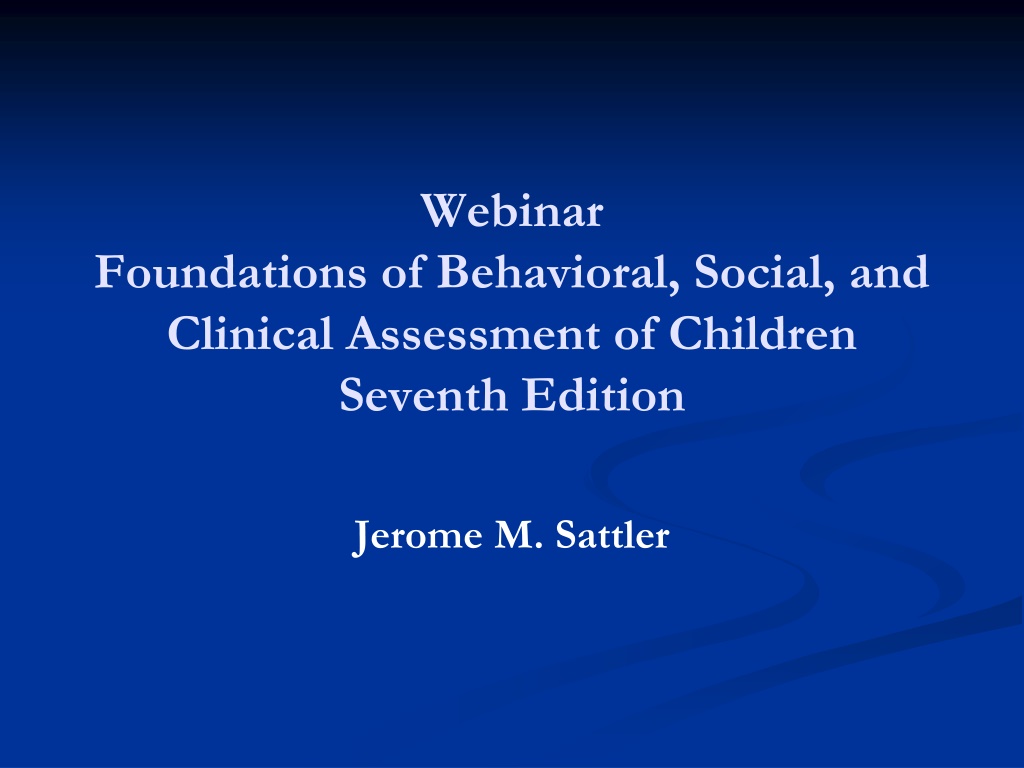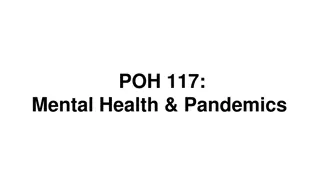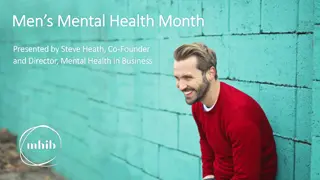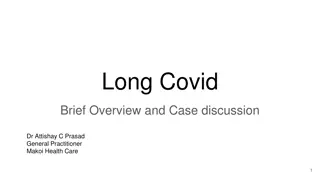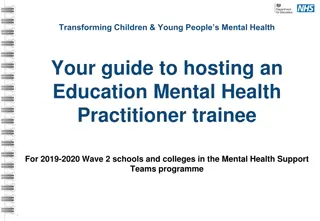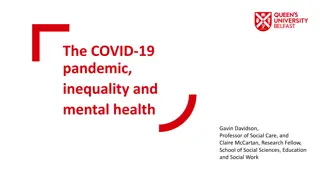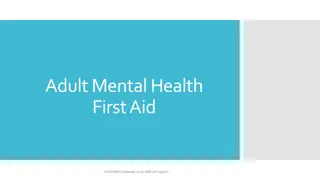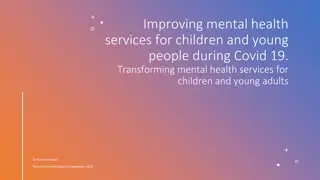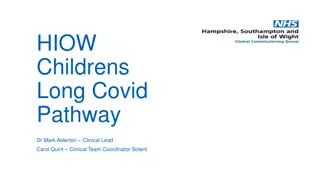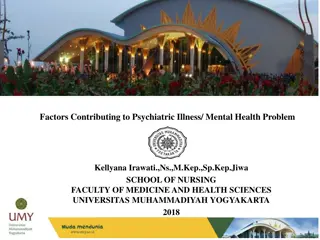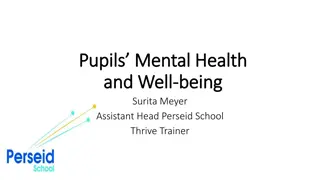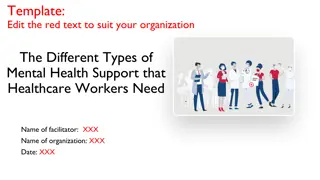Impact of COVID-19 on Children's Mental Health: Risk Factors and Challenges
The COVID-19 pandemic has brought about various stressors and risk factors affecting children's mental health, including disruptions in routine, financial instability, adverse childhood experiences, and more. Factors like caregiver burnout, frontline worker status, and urban living further compound these challenges. Children with disabilities and prior mental health conditions are at heightened risk, emphasizing the need for targeted support and intervention strategies during these difficult times.
Download Presentation

Please find below an Image/Link to download the presentation.
The content on the website is provided AS IS for your information and personal use only. It may not be sold, licensed, or shared on other websites without obtaining consent from the author. Download presentation by click this link. If you encounter any issues during the download, it is possible that the publisher has removed the file from their server.
E N D
Presentation Transcript
Webinar Foundations of Behavioral, Social, and Clinical Assessment of Children Seventh Edition Jerome M. Sattler
Introduction to COVID-19 [1] The COVID-19 pandemic can have serious consequences for children, parents, and their families Measures used to control the pandemic can affect children s development and impact family functioning
Introduction to COVID-19 [2] The COVID-19 pandemic and stress on children: Fear of quarantine Fear of getting the infection Frustration and boredom Inadequate information about the pandemic Lack of in-person contact with classmates, friends, and teachers Limited personal space at home Concerns about the family s finances
Risk Factors [1] Risk factors and children s mental health: Being worried about COVID-19 Experiencing disruptions in routine Experiencing financial instability, food shortages, or housing instability Experiencing adverse childhood experiences (e.g., abuse, neglect, community violence, discrimination)
Risk Factors [2] Risk factors and children s mental health: (Cont.) Having mental health challenges before the pandemic Having caregivers at elevated risk of burnout Having caregivers who are frontline workers Living in an area with more severe COVID-19 outbreaks
Risk Factors [3] Risk factors and children s mental health: (Cont.) Living in an urban area Losing a family member to COVID-19
Risk Factors [4] Children at greater risk: In immigrant households In rural areas Involved with the juvenile justice or child welfare system, runaway children, and children experiencing homelessness Discriminated in the health care system
Risk Factors [5] Children at greater risk: (Cont.) With intellectual and developmental disabilities With multiple risk factors With previous mental health conditions Culturally and linguistically diverse LGBTQ+ children Low-income children
Research Studies with Parents and Children on COVID-19 [1] At the time of this review, most studies were relatively short-term, and research is needed on the effects of COVID-19 over a longer term Most studies suggest that the school closings and social isolation connected with COVID-19 have negative consequences for children and their families
Research Studies with Parents and Children on COVID-19 [2] Although children may became more emotionally removed from their peers, they also may become more intimately involved in family relationships or experience a reduction in internalizing, externalizing, and other problems
U.S. Surgeon Advisory [1] Highlights of the U.S. Surgeon Advisory (2021) on the early effects of the COVID-19 pandemic: Research covering 80,000 youth globally found that: Depressive and anxiety symptoms doubled during the pandemic 25% of youth experienced depressive symptoms 20% of youth experienced anxiety symptoms
U.S. Surgeon Advisory [2] Highlights of the U.S. Surgeon Advisory (2021) on the early effects of the COVID-19 pandemic: Research covering 80,000 youth globally found that: (Cont.) Impulsivity and irritability have increased moderately
U.S. Surgeon Advisory [3] Highlights of the U.S. Surgeon Advisory (2021) on the early effects of the COVID-19 pandemic: (Cont.) Compared to the same period in early 2019, in 2020 emergency department visits in the United States for suspected suicide attempts were: 51% higher for adolescent girls 4% higher for adolescent boys
U.S. Surgeon Advisory [4] Highlights of the U.S. Surgeon Advisory (2021) on the early effects of the COVID-19 pandemic: (Cont.) Because pandemic-related measures reduced in-person interactions among children, friends, social supports, and professionals, it was harder to recognize signs of child abuse, mental health concerns, and other challenges
Health Care Claims and Emergency Department Visits in the United States[1] An examination of a database of over 32 billion private healthcare claims in the United States indicated the COVID-19 has serious consequences for children s mental health
Health Care Claims and Emergency Department Visits in the United States[2] Compared to March and April 2019, the claims in 2020 for children ages 13 to 18 years: Mental health increased by almost 100% Intentional self-harm and substance abuse increased by over 90% Generalized anxiety disorder increased over 90% Major depressive disorder and adjustment disorder increased over 80%
Health Care Claims and Emergency Department Visits in the United States[3] From the Spring of 2020 to November 2020, claims for children ages 6 to 12 years for obsessive-compulsive disorder and tic disorders increased (26.8% and 28.7%, respectively) from their levels in the corresponding months of 2019
Health Care Claims and Emergency Department Visits in the United States[4] During 2020, there was a 31% increase in mental health related emergency department visits among children aged 12 to 17 years compared to the previous year
Interventions [1] Mental health interventions should focus on children, parents, siblings, and family dynamics in the context of acceptable telemental health services with a component, where needed, that includes in-person, video, or phone calls Having young children engage in pandemic-related pretend play may help them cope better with the pandemic
Interventions [2] Children who face childhood trauma will experience the effects of the COVID-19 pandemic in ways that are different from those who have more normal childhoods. And when they reach adulthood, they are likely to face additional challenges
Interventions [3] Future research should focus on the delivery of evidenced-based, age-appropriate mental health services and, if the pandemic continues, we need to monitor the impact of the pandemic on children s mental health
Preventing School and Community Violence [1] Overview of the Interdisciplinary Group on Preventing School and Community Violence See website (www.sattlerpublisher.com) under Other Publications
Preventing School and Community Violence [2] A national requirement for all schools to assess school climate and maintain physically and emotionally safe conditions and positive school environments that protect all students and adults from bullying, discrimination, harassment, and assault Adequate staffing (such as counselors, psychiatrists, psychologists, and social workers) of coordinated school- and community-based mental health services for individuals with risk factors for violence, recognizing that violence is not intrinsically a product of mental illness
Preventing School and Community Violence [3] Reform of school discipline to reduce exclusionary practices and a focus on prevention that fosters positive social, behavioral, emotional, and academic success for all students A national program to train and maintain culturally proficient school- and community-based crisis intervention and threat assessment teams that include mental health and law enforcement partners
Preventing School and Community Violence [4] Removal of legal barriers to sharing safety-related information among educational, mental health, and law enforcement agencies in cases where a person has threatened violence
Preventing School and Community Violence Resources in Behavioral 7th[4] School climate: See pp. 56-57 See pp. 590-593 School violence: See p. 540 (Checklist of Risk Factor for Potential Violence) See pp. 544-546 Trauma Informed Care: See pp. 559-562
Chapter 1 Introduction to the Behavioral, Social, and Clinical Assessment of Children
Technical and Clinical Skills Needed (pp. 2-3) Look over the 19 technical and clinical skills listed on p. 2 that are needed to be a competent clinical evaluator. Also see Table 1-1, p. 3, for a list of books, online publications, and journals that are helpful for evaluators.
Variables to Consider in a Multimethod Assessment (Figure 1-2 on p. 7 and pp. 6-14) Input Innate factors Background variables Intervening variables Assessment situation Test demands Output Assessment data
Evaluator Characteristics that Affect the Assessment (pp. 11-12)[1] Evaluator s: Techniques and style Personal needs Personal likes, dislikes, and values Ability to attend to the child s needs Ability to focus on and understand the child Selective perceptions and expectancies Ethnic, cultural, and class status
Evaluator Characteristics that Affect the Assessment (pp. 11-12)[2] (Continued) Evaluator s: Assessment plans Administration techniques Interpretation of assessment findings Theoretical position
Child Characteristics that Affect the Assessment (p. 12) Child s: Affect and attitude toward the testing Understanding of the test directions Cognitions Language Personal likes, dislikes, and values Behavior
Steps in a Multimethod Assessment (Figure 1-3, pp. 14 20) [1] Step 1: Review referral information Step 2: Decide whether to accept the referral Step 3: Obtain relevant background information from questionnaire and prior records Step 4: Interview the child, parents, teachers, and relevant others Step 5: Observe the child in several settings Step 6: Select and administer a test battery
Steps in a Multimethod Assessment (Figure 1-3, pp. 14 20) [2](Continued) Step 7: Interpret assessment results Step 8: Develop intervention strategies and recommendations Step 9: Write a report Step 10: Meet with the child (if appropriate), parents, and other concerned individuals Step 11: Monitor the effectiveness of the recommendations
Questions to Consider When Reviewing an Assessment Measure (p. 17) See Table 1-3 on p. 17 Information about the assessment measure Information about administering the assessment measure Information about scoring the assessment measure Child considerations
Theoretical Perspectives for Behavioral, Social, and Clinical Assessments (pp. 20, 22 29) [1] Developmental Perspective (p. 24) Normative-Developmental Perspective Ecological-Transactional Perspective Cognitive-Behavioral Perspective Family-Systems Perspective
Theoretical Perspectives for Behavioral, Social, and Clinical Assessments (pp. 29 36) [2] (Continued) Social-Cognitive Perspective Sociocultural Perspective Neurodevelopmental Perspective Eclectic Perspective (p. 35)
Approaches to Classification (pp. 36 37) Two important dimensions of personality Internalizing dimension includes symptoms such as withdrawal, anxiety, and inhibition Externalizing dimension includes symptoms such as aggression, anger, and defiance
Clinical Approach- Classification (pp. 37-39) DSM-5 disorders that may be evident in childhood & early adulthood (see Table 1-4 on pp. 38-39) 14 disability categories of IDEA 2004 (see Table 1-5 on pp. 40-41; U.S. Only) Students served under IDEA (see Table 1-6 on p. 41; U.S. Only)
Risk and Protective Factors (pp. 43 49) Risk outcome cycle (see Figure 1-6 on p. 45) Risk factors (see Table 1-7 on p. 44) Protective factors (see Table 1-8 on p. 46)
Ethical & Legal Considerations (Table 1-9, p. 49 54) [1] Ethical and Professional Guidelines (see Table 1-9 on p. 50)
Ethical & Legal Considerations (p. 49 54) [2] (Continued) Confidentiality & Privileged Communication Confidentiality is the ethical obligation of a professional not to reveal information obtained through professional contact with a client without specific consent from the client or the client s legal representative Privileged communication is a legal status granted by state and federal laws to communications made to designated individuals (usually professionals or close family members)
Ethical & Legal Considerations (Table 1-10, p. 49 54)[3] (Continued) Key ethical principles for behavioral, social, and clinical assessment (see Table 1-10, pp. 51-52)
Children with Special Needs (pp. 54 55) See the 13 Guidelines for Working with Children with Special Needs on p. 55
Guidelines for Intervention and Prevention (pp. 55-56) [1] Include family members, school personnel, and members of the neighborhood as active participants in an intervention program Break the cycle that leads to negative behavior in children Help children become more resilient in facing aversive situations
Guidelines for Intervention and Prevention (pp. 55-56) [2] (Continued) Mobilize additional protective resources that can foster individual resilience Encourage schools to provide a setting where children can become connected with caring, competent adults
Chapter 2 Conducting the Assessment
Observing Children: During the Assessment (pp. 80-91) [1] Questions to consider about a child during an assessment (see Table 2-3, pp. 81-84)
Observing Children: During the Assessment (pp. 80, 84-90) [2] (Continued) Observing nonverbal behavior Possible Meanings of Nonverbal Behaviors (Table 2-4, p. 85) Observing verbal behavior Problems in Language Development (Table 2-5, pp. 87- 88)
Behavior & Attitude Checklist (Table 2-6, pp. 90-91) The Behavior and Attitude Checklist (Table 2-6, p. 91)
